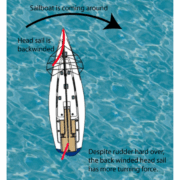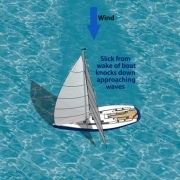What about COB – Captain overboard?
Last week we made a pretty good point about using the engine as your first method of pick up when you have a man overboard while under sail. And it was quite well received by followers – thanks. Many sailing schools teach the figure 8 recovery method whilst under sail and this is correct we believe so long as it is used as the second method for recovery.
But it may need to be the first if someone has the engine keys in their pocket. Durh!
The problem is that it’s usually the captain who turns off the engine and puts the keys away secure in his/her pocket. And it’s many times the captain who is the most competent sailor and worse yet if the only competent sailor aboard or not aboard as in the case of COB.
The scenario is now pretty easy to realize. Captain goes overboard with keys in pocket and a non experienced crew left on board to sail the boat to a recovery pick up.
Leave the keys in an accessible place. Have a second set of keys available in the chart table and ensure every one knows the COB (captain overboard) recovery plan.
Sailing schools in particular should take notice here because many times you have novice students who are just learning to sail loaded on the boat. Make COB part of your initial briefing.
When on a bareboat charter make a keys talk part of your initial briefing to everyone.
Stormy conditions? Remind everyone about MOB and COB during the batten down the hatches phase.







Admin: This was a comment back on the MOB discussion from a linked-in group we are on.
Grant,
I appreciate the link to your website. Interesting, and sure to engage for a while to review the resources you offer there.
That said, I respectfully disagree with you about the efficacy of recovering a MOB using the engine when under sail. Have you read all the cases in the US Sailing study here: http://www.ussailing.org/safety/Studies/lifesling_history.htm ? That compilation of studies is far from unique.
Big trouble comes from a sequence of failures–operational, mechanical, systemic, human. Time after time in the case studies (real world stuff) a line wraps around the propeller. Particularly with a novice crew, one cannot expect a careful check for lines over the side before engaging the transmission.
Accordingly the policy on my boat is to use the quick stop maneuver and an upwind recovery. Don’t touch the sheets, don’t worry about anything except driving the boat and keeping the MOB in sight.
Incidentally, chasing a coozie, a hat, or a cushion is interesting and makes the point about the importance of MOB recovery practice to crew (and captains), but it isn’t representative. Those objects blow downwind much more quickly than a person in the water. I use a spherical fender with a large bucket as a drogue for a more realistic MOB dummy.
When I lived in the UK I found that MOB recovery practice was a much more common occurrence amongst frequent sailors than I have experienced in the US. American sailors would be well-served to consider some of the practices of our European brethren to keep skills sharp.
sail fast and eat well, dave
S/V Auspicious
ADMIN: and here was my thoughts on the great comment.
Grant:
Dave
Totally appreciate where you are coming from. Lines around the prop are bad. Perhaps I should preface the article with people should first consider their best method of pick up according to their abilities and how much they have practiced the drill. And they should think about this before an MOB rather than at the time. If they thought about it before they might practice a bit more :). However what i see actually in practice and reality is that people are mostly unpracticed on this and sailing back to an MOB is a disaster. When you have frigid cold water – it’s a real issue with the time in the water.
You point is well taken in that it’s a complicated issue. A novice can’t sail back to an MOB and be expected to stop immediately next to the MOB but might get the line caught in the prop. An expert might think he’s an expert and miss attempts delaying the recovery. But an expert also knows to make sure that lines aren’t in the water.
What ever the answer – people need to have a plan and be able to execute that plan.
One student here in Austin nearly killed someone by not being able to get back to the MOB in winter cold water – with a heart condition. If they’d simply turned on the engine that serious issue would have been much less potentially disastrous.
I know on my boat the policy is for a line check every time the engine is turned on – but hey what if i go overboard?
The other point is what if you fell overboard in frigid water and you had a novice crew???
This is a hotly debated topic for many years since the steam engine was invented i’m sure. One thing is for sure – i would not have wanted to fall overboard in the ol square rigger days in the middle of the northern atlantic.
I think it’s a great topic for this group to pick up and continue discussing. Lets hear from other real sailors and what they practically do.
I do think I’ll add this discussion to the learn to sail section in the skipper course on http://www.nauticed.org because people should be aware of the seriousness of the Man overboard topic.
Thanks for the comments!